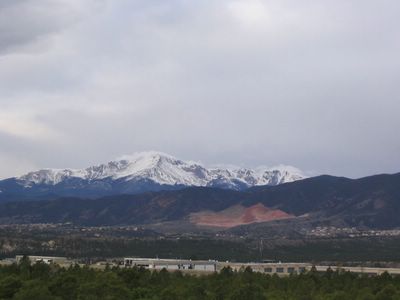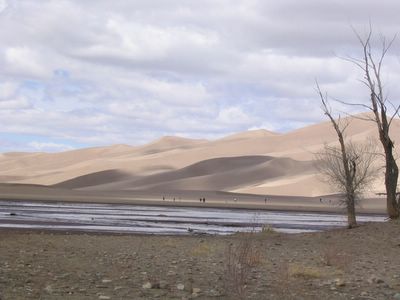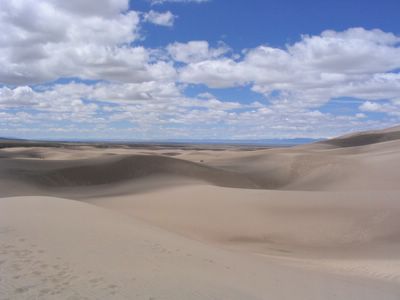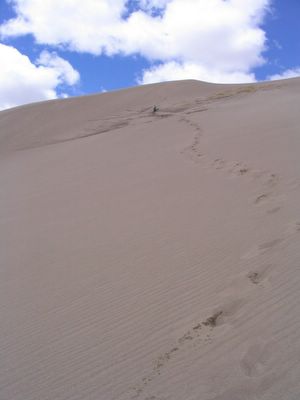Trip to the Sand Dunes National Park
Its spring and the temperature has been awesome. So a couple of friends and I decided to go on short trip somewhere in Colorado. One of my friends had described the sand dunes of Colorado to me when I first moved here. It has been on my list of "places to be visited" since then. Sometime last week, we decided to make a trip there.
Trivia
The area was previously a state park and just recently it was changed to a national park. For those who visit a lot of national parks, this is a blessing in disguise. Your 50$ annual National Park Pass can get you (one car) in without having to pay anything.
History behind the sand dunes
Most people's first reaction on seeing the dunes is "What the??? How the heck did desert sand make it all the way to 8000feet above sealevel. How is it that there's this type of topography right next to snow covered mountains?". Or something to that effect :-)! Probably the only place where you'll find the two contrasting geographical features right next to each other.
The following is an excerpt from an article on classbrain.com by Sarah Lane.
"Tucked against the Sangre de Cristo Mountains in south-central Colorado, the San Luis Valley is home to the tallest sand dunes in North America. Reaching heights of over 700 ft., the Great Sand Dunes National Monument and Preserve is constantly being restructured by the southwest winds that blow across the valley. The massive dunes hide a complicated system of wind, erosion, and sand deposition. For several thousand years westerly winds have traveled over the Rockies and down over the river flood plain, picking up sand particles from the valley and the Rio Grande River. The winds then deposit the finely-ground pumice, ash, quartz, and lava at the eastern edge of the valley before it rises to cross the Sangre de Cristo mountains. The process continues and the seemingly tiny sand particles group together to form the continuously changing dunes.
Aside from the attributes already mentioned, this park also contains the largest known stand in the United States of ponderosa pine trees bearing ancient tribal markings. Another amazing feature of the Great Sand Dunes is Medano Creek. This crazy stream starts in the Sangre de Cristo mountains, flows along the eastern edge of the dunes, and periodically disappears below ground in the valley. You can be standing in a fast-moving current measuring over a foot deep and then suddenly the water will stop and flow several meters away instead."
The trip
It was to be a 4-5 drive from Boulder to the sand dunes. We wanted to be at the park by about 10.00am. The official website recommends a 4-wheel drive vehicle for those who want to drive the single lane sand track between the dunes and the mountains. So, we made a rental reservation for an SUV. We went to the Denver International Airport to pick up the SUV at about 5.30am. This is probably the first time I've woken up early enough to see a full blooded sunrise out in the open here in Colorado. I've always headed straight into the mountains while skiing and so was driving away from the Sunrise. The sight was breath-taking. And I was lucky to have caught this particular scene.

The lighting across the plains changed so rapidly. Here's another picture taken about 30 seconds later.

We drove past Colorado Springs. Pikes Peak is the 14K+ moutain right next to Springs. Here's a picture of Pikes Peak.

Another snow capped peak on the way to the sand dunes. This is what I like best about spring. You have green everywhere on the plains and only the peaks are covered in snow. Its a nice feeling to be able to appreciate snow without feeling cold.

On the southern side of the Sangre de Cristo mountains. The dunes were on the other side of this range.

We drove around the range and here's a first view of the dunes..

View of the sand dunes from across the Rio Grande river. Notice the miniscule human beings down at the bottom of the dunes..

San Luis Mountains across the valley.

The Rio Grande river bed..the sand dunes meet the mountains.

Miles and miles of sand..

On my hike to the top.

Getting sandblasted on the top. The wind was extremely strong.

On the top, with the mountains in the back ground.

Me on one of the dunes..

Steep climb back down. Considering the great slopes out there in the dunes, sledding should be a fun thing to try out there. I made a mental note to myself to take a sled next time I go out there.

View from the base of the mountains.

Panoramic view of the sand dunes framed against the Sangre de Cristo mountains.

Trivia
The area was previously a state park and just recently it was changed to a national park. For those who visit a lot of national parks, this is a blessing in disguise. Your 50$ annual National Park Pass can get you (one car) in without having to pay anything.
History behind the sand dunes
Most people's first reaction on seeing the dunes is "What the??? How the heck did desert sand make it all the way to 8000feet above sealevel. How is it that there's this type of topography right next to snow covered mountains?". Or something to that effect :-)! Probably the only place where you'll find the two contrasting geographical features right next to each other.
The following is an excerpt from an article on classbrain.com by Sarah Lane.
"Tucked against the Sangre de Cristo Mountains in south-central Colorado, the San Luis Valley is home to the tallest sand dunes in North America. Reaching heights of over 700 ft., the Great Sand Dunes National Monument and Preserve is constantly being restructured by the southwest winds that blow across the valley. The massive dunes hide a complicated system of wind, erosion, and sand deposition. For several thousand years westerly winds have traveled over the Rockies and down over the river flood plain, picking up sand particles from the valley and the Rio Grande River. The winds then deposit the finely-ground pumice, ash, quartz, and lava at the eastern edge of the valley before it rises to cross the Sangre de Cristo mountains. The process continues and the seemingly tiny sand particles group together to form the continuously changing dunes.
Aside from the attributes already mentioned, this park also contains the largest known stand in the United States of ponderosa pine trees bearing ancient tribal markings. Another amazing feature of the Great Sand Dunes is Medano Creek. This crazy stream starts in the Sangre de Cristo mountains, flows along the eastern edge of the dunes, and periodically disappears below ground in the valley. You can be standing in a fast-moving current measuring over a foot deep and then suddenly the water will stop and flow several meters away instead."
The trip
It was to be a 4-5 drive from Boulder to the sand dunes. We wanted to be at the park by about 10.00am. The official website recommends a 4-wheel drive vehicle for those who want to drive the single lane sand track between the dunes and the mountains. So, we made a rental reservation for an SUV. We went to the Denver International Airport to pick up the SUV at about 5.30am. This is probably the first time I've woken up early enough to see a full blooded sunrise out in the open here in Colorado. I've always headed straight into the mountains while skiing and so was driving away from the Sunrise. The sight was breath-taking. And I was lucky to have caught this particular scene.

The lighting across the plains changed so rapidly. Here's another picture taken about 30 seconds later.

We drove past Colorado Springs. Pikes Peak is the 14K+ moutain right next to Springs. Here's a picture of Pikes Peak.

Another snow capped peak on the way to the sand dunes. This is what I like best about spring. You have green everywhere on the plains and only the peaks are covered in snow. Its a nice feeling to be able to appreciate snow without feeling cold.

On the southern side of the Sangre de Cristo mountains. The dunes were on the other side of this range.

We drove around the range and here's a first view of the dunes..

View of the sand dunes from across the Rio Grande river. Notice the miniscule human beings down at the bottom of the dunes..

San Luis Mountains across the valley.

The Rio Grande river bed..the sand dunes meet the mountains.

Miles and miles of sand..

On my hike to the top.

Getting sandblasted on the top. The wind was extremely strong.

On the top, with the mountains in the back ground.

Me on one of the dunes..

Steep climb back down. Considering the great slopes out there in the dunes, sledding should be a fun thing to try out there. I made a mental note to myself to take a sled next time I go out there.

View from the base of the mountains.

Panoramic view of the sand dunes framed against the Sangre de Cristo mountains.



3 Comments:
Wow! Sand dunes right next to snow caps! The snap that shows both is out of the world! Nature in all its beauty!:-)
Oh yeah!
When I was at Los Alamos, I used to go there almost every weekend and do some good climbing. Sangre de Cristos are fabulous for climbing and some of them are quite hard to. And ofcourse, the Fourteeners.
God, I miss that part of the country so much. I've been planning to climb Mt. Blanca for a long time now, hopefully I will before the heat death of the Universe. =)
So, did you go to the sand dunes at all?
Next time you come to this side of the country, make sure you come further up north to Rocky Mountain National park.. There is a really tough 4.5 mile hike from Bear lake to the continental divide. That should throw you a few nasty surprises :-)..
Post a Comment
<< Home